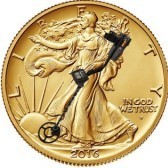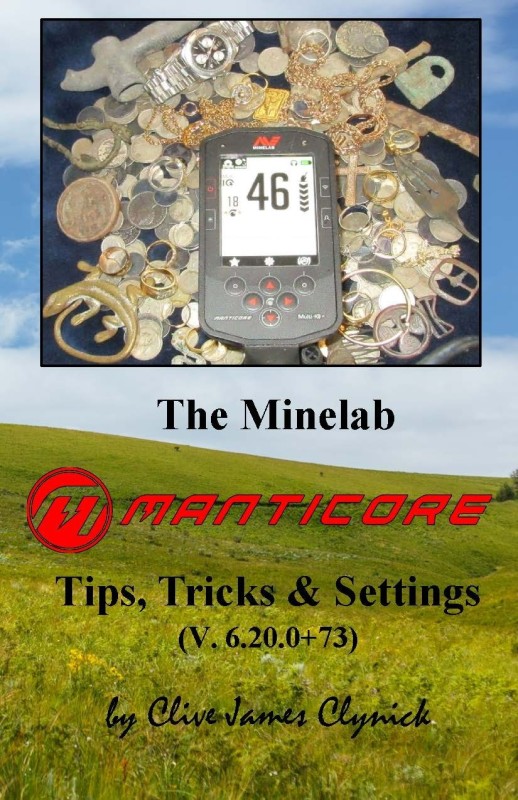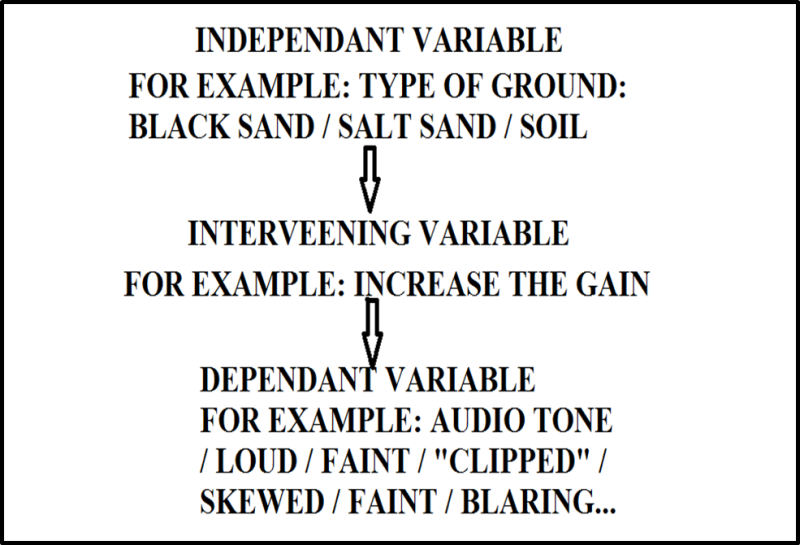-
Posts
514 -
Joined
-
Last visited
-
Days Won
1
cjc last won the day on October 11 2023
cjc had the most liked content!
Profile Information
-
Gender
Male
-
Location:
Toronto Canada
-
Interests:
Detectors, gold....that's it.
-
Gear In Use:
Macro Racer 2, Sov X2 , Excal 1000, Excal 11, Barracuda, (3) GQA2, , Whites Dual Field (2), CZ5, CS6PI...CTX 3030,, mpact, w/p TDI Pro., NOX 800, Fisher Impulse AQ, Simplex +, Anfibio, Legend,
Contact Methods
-
Website URL
http://clivesgoldpage.com/
-
Facebook
clivesgoldpage
cjc's Achievements

Gold Contributor (5/6)
1.1k
Reputation
-
Maybe a factory reset? lol I actually stood on the button for longer and got it to reset--thanks for your reply though, Steve. cja
-
ya but the machine wont turn on to perform a power button reset...I have the sampe poblem mid vacay--she's done. tried the salt / vinegar, baking soda water thing, no go.
-
A Beginner's Guide to the Nokta / Makro Legend (v.1.09 / v.1.10 beta) “Jam packed with tons of good info!!” AP “Great book! I just finished it. Loads of information on how the detector works. Plus, tests and techniques.“ WE “...Invaluable reference book for any Legend user!” LD, UK “A great read-- must have guidebook. Thanks Clive” GK “I bought this book and for me it has been bloody brilliant.” PP “Great read, thanks Clive!” CS Understanding the Nokta / Makro Legend (v.1.10 beta) Clive James Clynick has detected for over 40 years and is the author of 24 detector “how to” manuals, numerous articles and product reviews. Topics include: • Customizing the Legend for Your Sites and Type of Hunting. • Navigation: “Fiddle Less and Hunt More.” • Getting Results with the Legend at Tough Sites. • Coil Control Target Testing and Other Skills. • Understanding Fast Digital and Multi Frequency Detectors. • Bottle Caps and Other Problem Targets. • The Legend as a Gold Jewellery Hunting Machine. • Understanding the Updates (v. 1.05-v.1.10 beta). .…and Much More… “the only up-to-date book on the Legend” (Softbound, 101 pgs). Ordering and Reviews: http://clivesgoldpage.com/
-
The Minelab Manticore: Tips, Tricks and Settings (V. 6.20.0+73) “If you own the Manicore, I highly recommend reading this book. As a beach hunter it gave me a better understanding of the Manicore’s sensitivity set up and by how adjusting other settings allows for a more stable machine with higher settings.” RP, AUS “Awesome info In this book & also very detailed –a good addition to the tool box, I’m very pleased w my purchase.” RK “For anyone trying to figure out the Manticore, this is a must read. Clive really understands the ins and outs of detectors, and goes into great depth on what you could be doing to eliminate trash and find the good stuff. Get this book, read it, read it again, and stop wasting time digging so much trash!” DN “Well worth the money, I have read my copy a number of times and it really has helped me get the most out of the Manicore and getting it to perform in a manner that suits me either in the bush or in salt water at beaches. Well done and thanks Clive.” PR “Great book!” DL The Minelab Manticore: Tips, Tricks and Settings (V. 6.20.0+73) Clive James Clynick has been finding gold, silver, coins and relics with a metal detector for over 40 years. He is the author of some 26 “how to” books and numerous articles for the serious treasure hunter. Topics include: Getting the Most from the Manticore’s Power. Creating Custom Settings for Your Sites and Hunting Style. Understanding the Manticore’s Graph and Expanded Meter. Understanding the Audio Options. Deep Silver Skills: Spikes, False Signals and “Masked” Targets. Using Basic Skills to Enhance the Manticore’s Target ID Features. Working on Your Accuracy and Conclusiveness. The Manticore as a Gold Jewellery Hunting Machine. Pro-Level Testing and Tuning Methods. ...and much more... ($16.95, Softbound, 108 pgs) Ordering and Reviews: http://clivesgoldpage.com/
-

Need A New Pi For Beach Detecting
cjc replied to Hard Prospector's topic in Metal Detector Advice & Comparisons
I agree with Steve--its the SMF platform and how it relates to ground and targets--a broader cause. Hope the broad-based testing model helps you with your next experiment. But when I say "jam my books down anyone's throat" I mean the detecting public--not anyone in particular and it's a bit harsh to frame it that way. When I started basic theory and skills werre the first thing we learnt. Now it's all settings, "tweaks" and watching for numbers on a screen. Best of Luck. cjc -

Need A New Pi For Beach Detecting
cjc replied to Hard Prospector's topic in Metal Detector Advice & Comparisons
32/ Appendix III: Testing the Manticore as You Hunt Trial, error and testing is the “meat and potatoes” of becoming accurate with the Manticore. The more prepared you are from testing under controlled conditions the better armed you are against frustration in the field. While there are lots of test models that rely on cross-comparison between targets buried at various depths, the model I favour is based on the idea that to be certain of something--you need to try your best to disprove it. The idea is to push the detector until it stops performing. You then have a good idea of when this is happening in the field. Begin with a buried target of the type you hunt. Then try some basic experimental design. Let’s begin with some definitions: 1/ Independent Variable: This is the factor that does not change. 2/ Dependant Variable: This is the one that does change. 3/ Intervening Variable: This is the one that causes the change in the Independent Variable--the middle one--the “monkey wrench.” So, if you take a basic test on our buried target, the ground conditions and target itself are the Independent Variables--unchanging--for now. The signal tone is the Dependant Variable. (Loud / quiet / broken, no sound would be some possible outcomes…). Then bring in some Intervening Variables: These might involve increasing the Sensitivity, changing the Recovery Speed or Ferrous Limits--it’s your choice. This model gives you an organized framework with which to test not only single Intervening Variables--but also several at one time--to begin to understand the interactions. Conversely, next--the ground conditions or type of target themselves could be used as the Independent Variable (for example black or normal sand as separate trials or gold versus silver) --with an individual setting or complete mode as the Intervening--and again--the audio tone as your test result (Dependant Variable). While all this may sound a bit stuffy--it’s the way to get a good clear understanding of what the Manticore will and won’t do in the various modes and settings--under different actual conditions. This is much more “hands on” and fluid than Simple “on the fly” experimental design is a good way to learn more about your machine as you hunt. some artificially created test garden in your backyard. As well--these are tests you can perform as you hunt. Another way to do this is to “start with an in-ground signal and try to make it worse.” This might involve changing modes, increasing the Sensitivity, or changing the Recovery Speed or Ferrous Limits. The great thing about this kind of testing is that you can begin with extreme settings and learn what bad tuning sounds like. This tells you what to listen for in more typical situations. Using this model some interactions to look at would be how: · Again, the general principle is that when you move too far from the pre-set range with any of these controls--there needs to be compensation with one or more of the others--or at least your sweep speed. · Remember, begin with extreme settings to create a “benchmark” for each negative effect. This gives you the clearest data--models to watch for in the field. Being able to make these “ear to coil” calls is the way to accomplish a balanced signal under any conditions. You first have to know what an unbalanced one sounds like. Besides signal tone, meter stability is another Dependant Variable to experiment with. Then of course there’s the old test garden Dependent Variable of depth… · A more complete list of audio characteristics to look for would be: wide / narrow / “peaked” / loud / faint / clipped / weak / “skewed” (forward or back) / flat / blaring / “squeak” / relationship to threshold…(is the response “flat” or does it “jump out?)” · (I would include “bittyness” here but that’s more of an “in-ground overall signal characteristic). All of these can provide useful target information and inform your settings tests. The key is to begin with extreme settings so as to be able to recognize the various performance changes. This will help to develop your tuning skills a lot. From: "The Minelab Manticore: Tips, Tricks and Settings" by clive james clynick. -

Need A New Pi For Beach Detecting
cjc replied to Hard Prospector's topic in Metal Detector Advice & Comparisons
What Im saying is that a nickel is more suseptable to detection problems that are a result of sensitivity too high, bias too high, EMI or just bad ground. In effect the more sensitive and exact a machine is--the more this is true. Could also be a "bleached" nickel. Try another target before deciding that the Manti--with all it's choices and fidelity is oh-so- terrible--andthat no adjustment could solve the problem. Your test is interesting, but not conclusive. This why Im about sick of trying to jam my books down the throats of people who don't think that basic detector theory is of any value. As machines become more involved people want to rely on the tech (presets for example) alone without having the broader understanding of ground, detection, detector features and target types. When I use a term like "signal balancing" not many even know whats being balanced in relation to what--why bother? They are thrashing about in effects, as if they were causes. cjc -

Need A New Pi For Beach Detecting
cjc replied to Hard Prospector's topic in Metal Detector Advice & Comparisons
Nickel is a partly magnetic coin. That's not to say that a a magnet will pick it up, but it's properties are very, very different from gold. A detector which is engaged in processing out inconsistent / random indications such as the ground will have no problem mistaking that type of target for the background. Really more of a demo of target types than anything to do with how good the Manti is--unless you hunt exclusively for nickels. A little basic theory goes a long way. A detector does not punch though the ground to detect a target--it separates the two. Sometimes the two are near identical. Overall the ground's signal is larger, thus, the higher you turn the machine up, the less separation you get on this type of target. Try testing your VLF indoors and in partucular, not what happens when you slow it right down. At a certain point it has time to make the distinction between EMI and target. The ground's "interference" is lessor--but no different. Where you have a lot of electricity in the ground--such as near a big hotel--this masking is even greater. Not to say t hat a nickel is that bad of a tester--just that its not all that distinct from the ground. cjc -

Need A New Pi For Beach Detecting
cjc replied to Hard Prospector's topic in Metal Detector Advice & Comparisons
I would also add that it's not just fast salt and black sand that cripple VLFs. Its the interference created by inclines, hills, seabed contours, weed beds, different types of material under the coil--any number of things. There's just no contest. I too have engaged in this same wishful "VLFs have gotten so powerful" type thinking but found it to be not true. At the same time there's such a thing as benign conditons--or places where trash targets and the general depth of what there is to be found make VLF the way to go. cjc -

Need A New Pi For Beach Detecting
cjc replied to Hard Prospector's topic in Metal Detector Advice & Comparisons
All told I would have still given the good old DF more weight in this discussion in that it just has a lot of target information in the tone and is as deep as anything out there including the TDIBH. Ya it's got a bit of crackle but this is the interraction that makes it deep. Ya there are some great VLFs out now but in salt water or black sand there's still no contest. None of these MF detecctors handle fast salt all that well. Even a pulse with a small coil still needs to be balanced out to perfrom well in these conditons--proof positive that VLFs are faring much worse. The Impulse AQ is the creame of the PI crop but not for the PI novice--The build choices are not all good (Vishay pots) and other small bobos make it a troublesome detector to run. Its a machine with "rites of passage" that have to be surmounted to finally arrive at a place where you have had components fail, broken a few fragile bits and are at last ready to swing problem free. Over all though--a superb circuit and exacting service from FT. I have two and two DF's -- without them I would be competing on a level field and these days that can be hard. With a pulse, the worse the conditons the bigger the advantage. cjc -

Need A New Pi For Beach Detecting
cjc replied to Hard Prospector's topic in Metal Detector Advice & Comparisons
V ery nice, Tony. Good Luck, clive -

Tom Dankowski’s Settings For The Minelab Manticore
cjc replied to cjc's topic in Minelab Manticore Forum
I don't understand your question or the context--what post it's in response to. cjc -
you read my mind, Tony. I was just going to put up a post asking if anyone had had the 15 in to salt. NOX was pretty crappy overall just not handling the fast surf and contours. To be fair, 5 tone spreatd the signal out a bit and made it less chattery. Keep us posted... Regards clive








